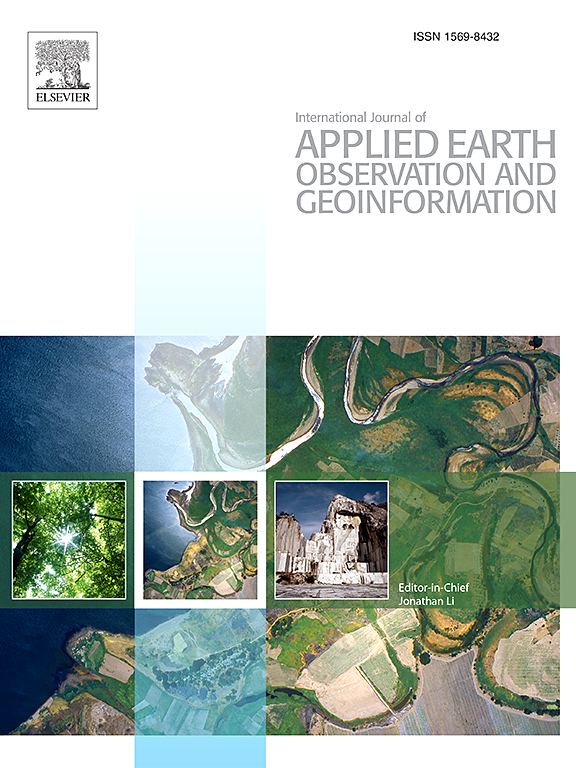Divergent crop mapping accuracies across different field types in smallholder farming regions
IF 7.6
Q1 REMOTE SENSING
International journal of applied earth observation and geoinformation : ITC journal
Pub Date : 2025-04-28
DOI:10.1016/j.jag.2025.104559
引用次数: 0
Abstract
Accurately mapping crop types in smallholder farming regions is crucial for monitoring crop dynamics and estimating production but remains challenging, especially over large extents. Remote sensing based crop mapping studies in smallholder farming regions often focus on major crops and the challenge of mapping small fields. However, minor but possibly emerging crops are often overlooked, nor is the impact of environmental factors, such as water stress, on mapping accuracy considered. This study addresses these gaps by categorizing crop fields into different types and assessing mapping accuracy for both major and minor crops within each field type. We first categorized crop fields into four field types (big/small fields with/without water stress) based on field size and the shortwave infrared water stress index (SIWSI) derived from Sentinel-2 (S2). Crop mapping accuracies for different field types and crops (maize as a major crop and soybean as a minor crop) were compared at pixel-based (PB) and object-based (OB) levels using random forest classification applied to S2 and two additional publicly accessible multispectral datasets (PlanetScope with four bands (PS4) and eight bands (PS8)). The season-averaged SIWSI (SIWSImean) provided a useful categorization of field types, as it is sensitive to mapping accuracy and is independent from field size. Based on S2 data, big fields without water stress can be most accurately mapped (F1-score = 0.89 for maize and 0.85 for soybean), followed by small fields without water stress (0.85 and 0.68) and big fields with water stress (0.82 and 0.59), while small fields with water stress are the most challenging type (0.77 and 0.37). Despite that the use of PS8 data with higher spatial resolution and OB classification improved mapping accuracy for small soybean fields with water stress, limitations to map such fields remain (F1-score < 0.50). This study provides a new perspective on crop type mapping in smallholder farming regions by using a simple and relevant categorization of field types and offers valuable insights on potentials and limitations for large-scale crop type mapping using machine learning algorithms.
在小农农业地区,不同农田类型的作物测绘精度存在差异
准确测绘小农种植区的作物类型对于监测作物动态和估计产量至关重要,但仍然具有挑战性,特别是在很大程度上。小农种植区基于遥感的作物制图研究往往侧重于主要作物和绘制小块农田的挑战。然而,次要但可能出现的作物往往被忽视,也没有考虑环境因素,如缺水胁迫,对制图精度的影响。本研究通过将作物田分类为不同类型,并评估每种田类型中主要和次要作物的制图精度来解决这些差距。首先,基于农田面积和Sentinel-2 (S2)卫星的短波红外水分胁迫指数(SIWSI),将农田分为大、小、无水分胁迫4种类型。利用S2和另外两个可公开获取的多光谱数据集(PlanetScope具有4个波段(PS4)和8个波段(PS8))的随机森林分类,比较了不同田地类型和作物(玉米为主要作物,大豆为次要作物)在基于像素(PB)和基于对象(OB)水平上的作物作图精度。季节平均SIWSI (SIWSImean)提供了一个有用的字段类型分类,因为它对映射精度很敏感,并且与字段大小无关。S2数据显示,无水分胁迫的大田最准确(玉米和大豆的f1得分分别为0.89和0.85),其次是无水分胁迫的小田(f1得分分别为0.85和0.68)和有水分胁迫的大田(f1得分分别为0.82和0.59),而有水分胁迫的小田是最具挑战性的类型(f1得分分别为0.77和0.37)。尽管使用具有更高空间分辨率和OB分类的PS8数据提高了水分胁迫下小块大豆田的制图精度,但这类田的制图仍然存在局限性(F1-score <;0.50)。本研究通过对农田类型进行简单而相关的分类,为小农种植区的作物类型制图提供了新的视角,并对使用机器学习算法进行大规模作物类型制图的潜力和局限性提供了有价值的见解。
本文章由计算机程序翻译,如有差异,请以英文原文为准。
求助全文
约1分钟内获得全文
求助全文
来源期刊

International journal of applied earth observation and geoinformation : ITC journal
Global and Planetary Change, Management, Monitoring, Policy and Law, Earth-Surface Processes, Computers in Earth Sciences
CiteScore
12.00
自引率
0.00%
发文量
0
审稿时长
77 days
期刊介绍:
The International Journal of Applied Earth Observation and Geoinformation publishes original papers that utilize earth observation data for natural resource and environmental inventory and management. These data primarily originate from remote sensing platforms, including satellites and aircraft, supplemented by surface and subsurface measurements. Addressing natural resources such as forests, agricultural land, soils, and water, as well as environmental concerns like biodiversity, land degradation, and hazards, the journal explores conceptual and data-driven approaches. It covers geoinformation themes like capturing, databasing, visualization, interpretation, data quality, and spatial uncertainty.
 求助内容:
求助内容: 应助结果提醒方式:
应助结果提醒方式:


